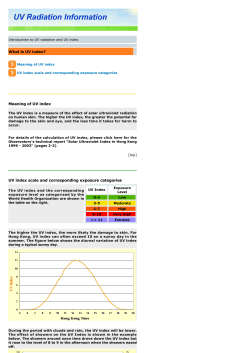
Multivariate Conditional Anomaly Detection for Clinical Anomaly
Multivariate Conditional Anomaly Detection
and Its Clinical Application
Charmgil Hong and Milos Hauskrecht
Computer Science Department
University of Pittsburgh
Pittsburgh, PA 15260
Abstract
This paper overviews the background, goals, past
achievements and future directions of our research that
aims to build a multivariate conditional anomaly detection framework for the clinical application.
Background and Goals
We humans are prone to error. Despite startling advances
in medicine, the occurrence of medical errors remains a
persistent and critical problem. Although various computeraided monitoring devices support medical practices to prevent errors, because those tools are primarily knowledgebased built by clinical experts, they are expensive and their
clinical coverage is incomplete.
We develop a new detection framework that identifies statistically anomalous patient care patterns based on past clinical information stored in an electronic health record (EHR)
systems. Our hypothesis is that the detection of anomalies
in patient care patterns corresponds to identifying cases that
need medical attention for reconsideration. Typical anomaly
detection methods, however, simply attempt to identify unusual data instances that do not conform with the majority of
examples in the dataset, and are not suitable in the clinical
context. This is because clinical decisions on patient care are
strongly based on the condition of the patient (Hauskrecht et
al. 2013). In addition, patient care generally consists of multiple clinical actions which often show correlations between
the individual actions (e.g., a set of medications that are usually ordered together). However, such correlations have not
been vigorously exploited in the context of anomaly detection. Our framework aims to improve the anomaly detection
performance by identifying multivariate conditional anomalies where we are interested in the patterns exhibit dependencies among individual clinical actions conditioned on the
patient condition.
Approaches
Our approach to identify multivariate conditional anomalies consists of the following two phases: (1) We first
build a predictive probabilistic model from EHRs using the
c 2015, Association for the Advancement of Artificial
Copyright Intelligence (www.aaai.org). All rights reserved.
multi-dimensional learning methods. Then, (2) we apply the
model to estimate an anomaly score that measures how unlikely a care pattern for the patient is. Below we further describe each of these phases.
Multi-dimensional Modeling of Clinical Data
Multi-dimensional classification (MDC) (Zhang and Zhou
2013) has received much attention in recent years, due to its
wide applications. For example, an image can be annotated
with multiple tags (Boutell et al. 2004); and a patient may
be diagnosed with multiple diseases (Pestian et al. 2007).
We formulate the modeling of EHRs in the MDC framework by assuming each patient is associated with d discretevalued class variables that represent patient care patterns.
The objective is to learn a function that assigns to each patient, represented by its feature vector x = {x1 , ..., xm },
the most probable assignment of the clinical actions y =
{y1 , ..., yd }. One approach to this task is to model the conditional joint distribution P (Y|X). Assuming the 0-1 loss
function, the optimal classifier h∗ assigns to an instance the
maximum a posteriori (MAP) assignment of class variables:
h∗ (x) = arg max P (Y = y|X = x)
(1)
y
= arg max P (Y1 = y1 , ..., Yd = yd |X = x)
(2)
y1 ,...,yd
A challenge in modeling P (Y|X) is that the number of
all possible class assignments is exponential in d. One may
tackle the issue by assuming all class variables are conditionally independent of each other and learn d models for
each class variable separately (Boutell et al. 2004). However,
this approach often fails because it does not take advantage
of the multivariate dependencies among the class variables,
which is the key to facilitate the learning of MDC.
Our goal in the first phase is therefore to develop efficient
multi-dimensional patient care models and methods that
overcome the above mentioned difficulties. We start from the
decomposition assumption has been introduced with Classifier Chains (Read et al. 2009). The method directly models
the class posterior distribution P (Y|X) by decomposing the
relations among class variables using the chain rule:
P (Y1 , ..., Yd |X) =
d
Y
i=1
P (Yi |X, Y1 , ..., Yi−1 ),
(3)
where each factor P (Yi |X, Y1 , ..., Yi−1 ) in the chain is a
classifier that is learned separately by incorporating the predictions of preceding classifiers as additional features.
In (Batal, Hong, and Hauskrecht 2013), we have proposed to restrict the dependency structure to a tree instead of a chain. By having the tree-structure assumption,
we presented an efficient structure learning method that
finds the optimal dependency relations among class variables, and a linear-time exact MAP inference algorithm
based on belief propagation (Koller and Friedman 2009).
Later, we extended the tree-structured model and developed
statistically sound multi-dimensional ensemble frameworks
(Hong, Batal, and Hauskrecht 2014; 2015). Compared to existing multi-dimensional ensemble approaches (Read et al.
2009), our methods learn models from data in more principled ways and produce more accurate and consistent results.
Multivariate Conditional Anomaly Detection
An important advantage of our multi-dimensional modeling approach compared to other MDC methods is that it
gives a well-defined model of posterior class probability.
That is, our model lets us estimate P (y|x) for any (x, y)
input-output pair. In addition, by exploiting the decomposable structure of the model (Equation 3), we can easily estimate the likelihood of each individual decision made on a
patient P (yi |x) – which in turn indicates how unlikely the
decision is based on the observation.
Based on this probabilistic measure, we use multiple approaches to estimate an anomaly score, which allows rankordering of anomaly candidates. In our preliminary study on
multivariate conditional anomaly detection, we showed the
validity of the approach using a Mahalanobis distance-based
anomaly detection method (Rousseeuw and Zomeren 1990)
on the posterior class probability P (y|x) to identify anomalous clinical decisions. We currently investigate on more
robust approaches to estimate the anomaly score that well
reflects the conditional dependencies among clinical decisions. We also study on how to pinpoint the cause of anomalies to provide more informative feedback.
Experimental Results
To validate our approach and demonstrate its effectiveness,
we present experimental results on a clinical dataset obtained from Cincinnati Childrens Hospital Medical Center (Pestian et al. 2007). The dataset has 978 instances;
each consists of 1,449 features (x) extracted from clinical
progress notes and 45 binary class variables (y) representing
the diseases diagnosed. We compared two of our chain variations – chain.mod1 (Batal, Hong, and Hauskrecht 2013) and
chain.mod2 (Hong and Hauskrecht 2015) – with the binary
relevance (BR) model (Boutell et al. 2004), which ignores
the relationships between individual clinical decisions. We
performed 10-fold cross validation with 3 repeats. On each
round, we perturbed 15% of test data by randomly flipping
1 to 5 class variables, and see whether the methods can correctly identify the anomalies. The anomaly score is evaluated by the Mahalanobis distance on the posterior class probability P (y|x).
Figure 1: Performance comparison in AUC.
Figure 1 shows the results in terms of the area under receiver operating characteristic (AUC). We can clearly see
that the anomaly detection performance has been consistently improved when the dependencies among clinical actions conditioned on patient condition are considered.
References
Batal, I.; Hong, C.; and Hauskrecht, M. 2013. An efficient probabilistic framework for multi-dimensional classification. In Proceedings of the 22nd ACM international conference on Conference
on information and knowledge management, CIKM ’13, 2417–
2422. New York, NY, USA: ACM.
Boutell, M. R.; Luo, J.; Shen, X.; and Brown, C. M. 2004. Learning
multi-label scene classification. Pattern Recognition 37(9):1757 –
1771.
Hauskrecht, M.; Batal, I.; Valko, M.; Visweswaran, S.; Cooper,
G. F.; and Clermont, G. 2013. Outlier detection for patient monitoring and alerting. Journal of Biomedical Informatics 46(1):47–55.
Hong, C., and Hauskrecht, M. 2015. Detecting multivariate conditional outliers using classifier chains. In (pending).
Hong, C.; Batal, I.; and Hauskrecht, M. 2014. A mixtures-of-trees
framework for multi-label classification. In Proceedings of the 23rd
ACM International Conference on Conference on Information and
Knowledge Management, CIKM ’14, 211–220. New York, NY,
USA: ACM.
Hong, C.; Batal, I.; and Hauskrecht, M. 2015. A generalized mixture framework for multi-label classification. In (pending).
Koller, D., and Friedman, N. 2009. Probabilistic Graphical Models: Principles and Techniques - Adaptive Computation and Machine Learning. The MIT Press.
Pestian, J. P.; Brew, C.; Matykiewicz, P.; Hovermale, D. J.; Johnson, N.; Cohen, K. B.; and Duch, W. 2007. A shared task involving multi-label classification of clinical free text. In Proceedings
of the Workshop on BioNLP 2007: Biological, Translational, and
Clinical Language Processing, 97–104. Stroudsburg, PA, USA:
Association for Computational Linguistics.
Read, J.; Pfahringer, B.; Holmes, G.; and Frank, E. 2009. Classifier chains for multi-label classification. In Machine Learning and
Knowledge Discovery in Databases, volume 5782 of Lecture Notes
in Computer Science, 254–269. Springer Berlin Heidelberg.
Rousseeuw, P. J., and Zomeren, B. C. v. 1990. Unmasking multivariate outliers and leverage points. Journal of the American Statistical Association 85(411):pp. 633–639.
Zhang, M., and Zhou, Z. 2013. A review on multi-label learning
algorithms. Knowledge and Data Engineering, IEEE Transactions
on PP(99):1.
© Copyright 2025















